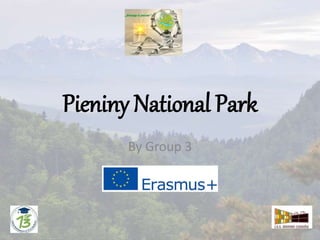Pieniny National Park
- 1. Pieniny National Park By Group 3
- 2. Location It is a protected area located in the heart of Pieniny Mountains in the southernmost part of Poland. Administratively, the Park lies in the Lesser Poland Voivodeship on the border with Slovakia. Its head office is in Kro≈õcienko nad Dunajcem.
- 4. The Pieniny mountain chain is divided into three ranges: Pieniny Spiskie, Małe Pieniny, and the Pieniny Właściwe range where the Park is located. The Park’s area is 23.46 square kilometres, of which 13.11 km² is forested. One- third (7.5 km²) is strictly protected. On the Slovak side of the mountains there is a parallel park called the Pieninský národný park.
- 6. History The idea for the creation of the National Park in Pieniny came from prof. Władysław Szafer, a member of the National Commission for the Preservation of Nature in 1921. In the same year a private preserve on the area of 75,000 m² was opened by Stanisław Drohojowski around the ruins of the Czorsztyn castle. In 1928 the Polish government made first land purchases and on May 23, 1932 the Ministry of Agriculture created a “National Park in the Pieniny”, on the area of 7.36 km². After the World War II, the decision was confirmed by the Oct 30, 1954 bill, which officially created Pieniny National Park.
- 7. Climate In terms of climatic conditions, the Pieniny mountains differ from neighbouring ranges and are characterized by mild climate. The distinct differences in microclimate between particular areas are related to variations in Pieniny relief. These climatic conditions also influence the biodiversity of flora and fauna in the region. The north-facing slopes and valley bottoms are markedly colder and more humid than the warm and arid microclimate of south-facing hillsides.
- 9. Flora The different forest habitats which do not create a homogeneous system, are the result of varied and diverse land forms. In Pieniny, almost no upland forests exist. One of the most striking features of the Pieniny forest cover is its diversity, which depends on the slopes' exposures. The northern slopes are predominantly covered by Dentario glandulosae – communities which favour brown soils as topsoils. The dominant species here are a combination of both Beech Fagus sylvatica and Fir Abies alba or just one of them mixed with Spruce Picea abies and deciduous trees: Sycamore Acer pseudoplatanus, Wych Elm Ulmus glabra, Broad-leaved Lime Tilia platyphyllos. Steep, south-facing slopes are overgrown by xerothermic Fir and Beech stands, in which the relative percentage of Fir and Beech trees depends on the location. The dominant species here are mixed with European Hornbeam Carpinus betulus, Sycamore Acer pseudoplatanus, Broad-leaved and Small-leaved Limes Tilia, European Ash Fraxinus excelsior and Wych Elm Ulmus glabra. Many rare and protected species which are found in the undergrowth, occur throughout the Southern Carpathians but exist in Poland only in the Pieniny mountains where they are at their northernmost European extreme: Sedge Carex alba, rare orchids – Broad Helleborine Cephalanthera damasonium.
- 10. Rare species Sedge Carex alba Broad Helleborine Cephalanthera damasonium
- 11. Fauna In terms of fauna, the Pieniny Mountains are the best studied area of Poland. The large number of species which occur here reflects the great variety of habitats. Pieniny NP has about 7,100 species, 25 of which were documented here for the first time. Species known or thought to occur in the Park amount to 13,000 – 15,000, constituting almost half the total known throughout the entire country of Poland.
- 12. Invertebrates Pieniny National Park is home to a wonderful variety of invertebrate life. So far about 6,800 species are found here. While there have been many studies of park invertebrates, not enough information is known to indicate exactly how many species occur here. Grasslands serve as excellent habitat for many interesting species. The easiest to spot are butterflies, e.g. Zygaena, Large Blues Maculinea. The most valuable and rare is the Apollo Butterfly. Pieniny meadows provide ideal sites for a wide variety of insects. Some of them are very rare and in Poland occur only in the Pieniny Mountains.
- 13. Apollo Butterfly
- 14. Fish and amphibians In the Pieniny area, the Dunajec river provides habitat for 17 species of fish. The most common ones are Chondrostoma nasus, Common Barbel. Unfortunately, nowadays, the Dunajec river is not good for salmonids. There are 10 amphibian species in Pieniny. Reptiles are represented by the Sand Lizard, Common Lizard, Slow-Worm, Grass-Snake, Smooth and Adder. All the species mentioned above are under protection in Poland.
- 15. A slow worm A common barbel
- 16. Mammals Mammals are represented by 61 species. The most numerous are small rodents of which the most noteworthy is the Herb Field Mouse. The Pieniny Mountains are home to 17 species of bats. Although recognized as an endangered species in Poland, Lesser Horseshoe Bats are rather common in Pieniny and the largest colony can be observed in Jaworki. The wide variety of Pieniny animal life also includes large mammals. The rarest amongst them is the Wild Cat. The Lynx is also extremely rare - the Pieniny population is estimated at just a few individuals. Sightings of Badgers, Weasels, and Foxes have been reported from the whole Pieniny area. The Dunajec river valley provides ideal nesting sites for Otters. Wolves can be seen occasionally in Pieniny when they come from the neighbouring Gorce mountain range. It is particularly exciting that traces of visiting Brown Bears have been observed in Pieniny in recent years. The most common large mammals are Roe-Deer.
- 17. A brown bear An otter A roe-deer
















